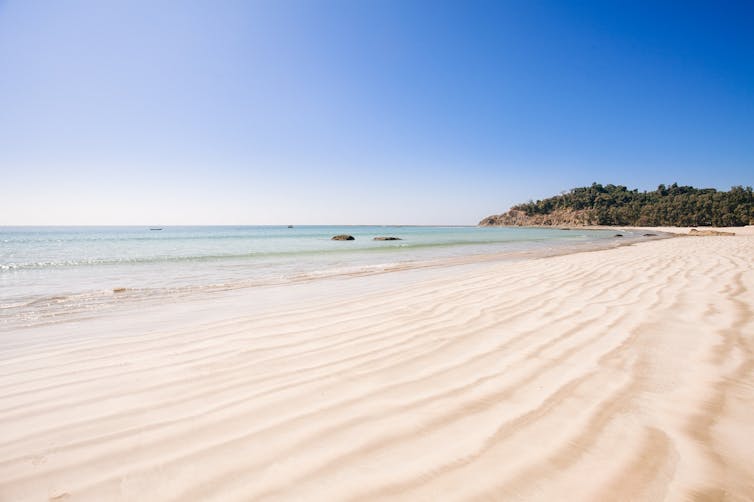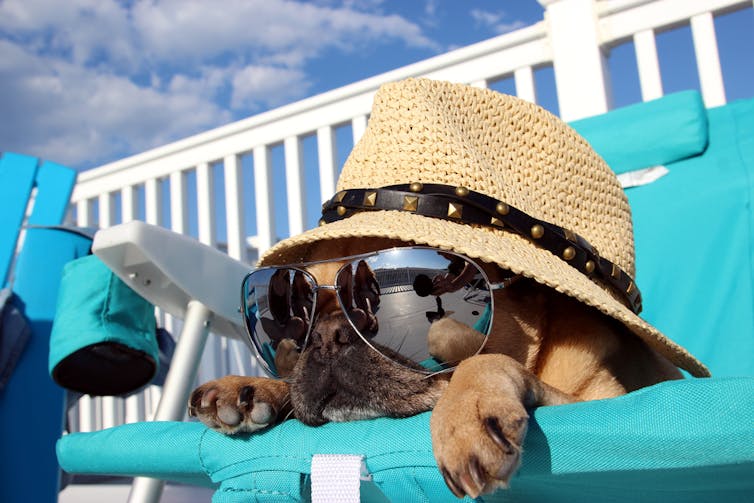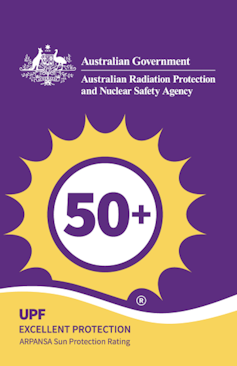Katie Lee, The University of Queensland and H. Peter Soyer, The University of Queensland
You may have seen them popping up on beaches everywhere – colourful, breezy, shady, beach cabanas.
Unlike beach umbrellas, they’re sturdy enough to withstand a stiff sea breeze and have pockets for sand to anchor them firmly. Best of all, there’s plenty of room for you, and your friends and family.
Some people have complained about beach cabanas blocking the view for other beach goers, and surf lifesavers. But beach cabanas are certainly having a moment in Australia. It’s a trend sun safety experts are keen to see continue.
But do beach cabanas provide as much sun protection as you think?
Chasing shade
Seeking shade is an important element of the slip-slop-slap-seek-slide method of sun protection (clothes, sunscreen, hat, shade, sunnies). The aim is to reduce your exposure to UV light, which is responsible for about 95 per cent of all skin cancers.
In Queensland alone, more people die from skin cancer than road crashes. Australia-wide, we spend $1.7 billion on skin cancer diagnosis and treatment a year.
Shading yourself from the direct sun will reduce your UV exposure by up to 75 per cent, depending on the surrounding environment.
People who frequently use shade are much less likely to be sunburnt than those who rely on sunscreen only. So beach cabanas seem to fit the bill nicely.
How much protection do they provide, exactly?
Beach cabanas are usually made from canvas, polyester or spandex. Look for fabric with UPF 50+ protection.
UPF (ultraviolet protection factor) ratings are similar to the SPF (sun protection factor) ratings on sunscreen. They measure the amount of UV that penetrates the fabric.
UPF 50+ means only 1/50th (2 per cent) or less of UV light gets through. That includes both UVA, responsible mostly for accelerated skin ageing, and UVB, responsible mostly for sunburn and skin cancers.
UPF ratings are accredited by the Australian Radiation Protection and Nuclear Safety Agency. Anything with its tag has been laboratory tested to show it does what it claims to.
Beware: reflection and scattering
However, you could still get sunburnt under your cabana. Although some brands say they offer “100 per cent protection”, that’s only from UV rays coming from above.
Sand can reflect up to 18 per cent of UV rays reaching the ground, concrete can reflect around 10 per cent, and a grassy park or backyard 2-3 per cent. In other words, you’ll still be exposed to UV reflecting off the surrounding surfaces and into the cabana from the sides.
Also, because of the way light is scattered in the atmosphere, UV light does not just come straight down from the sun but is also diffusely scattered in all directions.
So even when you are under shade, some of this scattered UV will still reach you. The more sky you can see, the more diffuse UV you are exposed to. This is where larger beach cabanas really win out over beach umbrellas.

Flo Dahm
So, can you still get burnt?
The amount of UV that causes just-perceptible sunburn on white skin is called a minimal erythemal dose (MED). A full day outside in the middle of an Australian summer will deliver 20-30 MEDs.
In the best-case scenario, your cabana shields you from 75 per cent of UV, so you could still get five MEDs on a full day at the beach. That’s enough for a very unpleasant burn for many people, even if they spent the whole day under cover. Spending time away from the shelter, exposes people to even more.
There has been little study of beach cabanas specifically. But there has been an Italian study of similar gazebos used by Tuscan lifesavers. This found that if people sat or stood under a gazebo between 8.30am and 4.30pm, they got 35 per cent of the UV they would have had in the full sun.
Someone lying absolutely flat would only get 10 per cent, but this seems an unlikely posture to maintain all day long.
You can’t just rely on your cabana
Fortunately, there are several sun protection practices you can layer with your shade.
A UPF 50+ rashie, and perhaps leggings, will help block UV reflection and also protect you when you’re in the surf or making an ice-cream run. Use sunglasses to protect your eyes from developing photokeratitis, a sunburn on the corneas of your eyes. Add a broad-brimmed hat when you leave the cabana.

Shutterstock
Sunscreen reapplied every two hours, and straight after swimming, will also protect you, but it’s not a suit of armour. For long exposure times it’s better to use it as a back-up to clothing for your face, neck, hands and feet.
Finally, consider heading indoors in the middle of the day when the UV index is at its peak.
Katie Lee, PhD Candidate, The University of Queensland and H. Peter Soyer, Professor of Dermatology, The University of Queensland
This article is republished from The Conversation under a Creative Commons licence. Read the original article.
Do you find beach cabanas annoying? Or are they just a part of beach life? Let us know what you think in the comments section below.



Look at the picture t the top of the article; almost no shade to be seen despite the plethora of these cabanas. Not much protection going on there.
The fact most people miss is that the cabanas, umbrellas or any other type of “shade”structure is for short term use. You should not be on the beach all day as you will become burnt. I shouldn’t laugh as I see parents with their children at the beach – kids have sunshirts on, but nothing on the legs usually but they put sunscreen and zinc on faces and hats on heads – all good things but a big part of the body is still exposed. I know from my childhood getting burnt time after time when on holidays at the beach. People still aren’t learning the lessons from older generations with skin cancer.